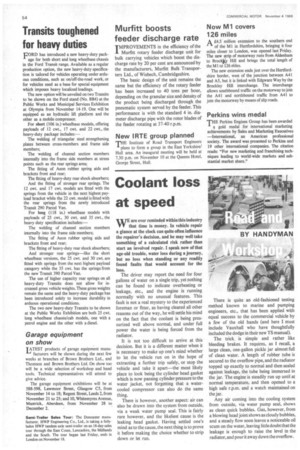Coolant loss at speed
Page 56

If you've noticed an error in this article please click here to report it so we can fix it.
WE are ever reminded within this industry that time is money. In vehicle repair a glance at the clock can quite often influence the repairer's decision, and he may well take something of a calculated risk rather than start an involved repair. I speak now of that age-old trouble, water loss during a journey, but no loss when standing or any readily found faults that would account for the loss.
The driver may report the need for four gallons of water on a single trip, yet nothing can be found to indicate overheating or leakage, etc., and the engine is running normally with no unusual features. This fault is not a real mystery to the experienced foreman or fitter, as having cleared all other reasons out of the way, he will settle his mind on the fact that the coolant is being pressurized well above normal, and under full power the water is being forced from the radiator.
It is not too difficult to arrive at this decision. But it is a different matter when it is necessary to make up one's mind whether to let the vehicle run on in the hope of extracting a further trip safely, or stop the vehicle and take it apart—the most likely place to look being the cylinder head gasket which is now passing cylinder pressure to the water jacket, not forgetting that a watercooled compressor can also do the same thing.
There is however, another aspect: air can also be drawn into the system from outside, via a weak water pump seal. This is fairly rare however, and the likeliest cause is the leaking head gasket. Having settled one's mind as to the cause, the next thing is to prove it before making the choice whether to strip down or let run.
There is quite an old-fashioned testing method known to marine and pumping engineers, etc., that has been applied with equal success to the commercial vehicle by a few of the old hands (and here I must include Vauxhall who have thoughtfully included the dodge in their new TS manual).
The trick, is simple and rather like bleeding brakes. It requires, as I recall, a large clean, one-gallon pickle jar almost full of clean water. A length of rubber tube is secured to the overflow pipe, and the radiator topped up exactly to normal and then sealed against leakage, the tube being immersed in the jar. The engine is steadily run up until at normal temperature, and then opened to a high safe r.p.m. and a watch maintained on the jar.
Any air coming into the cooling system from outside, via water pump seal, shows as clean quick bubbles. Gas, however, from a blowing head joint shows as cloudy bubbles, and a steady flow soon leaves a noticeable oil scum on the water, leaving little doubt that the leakage is enough to raise the level in the radiator, and pour it away down the overflow.








































































































































































